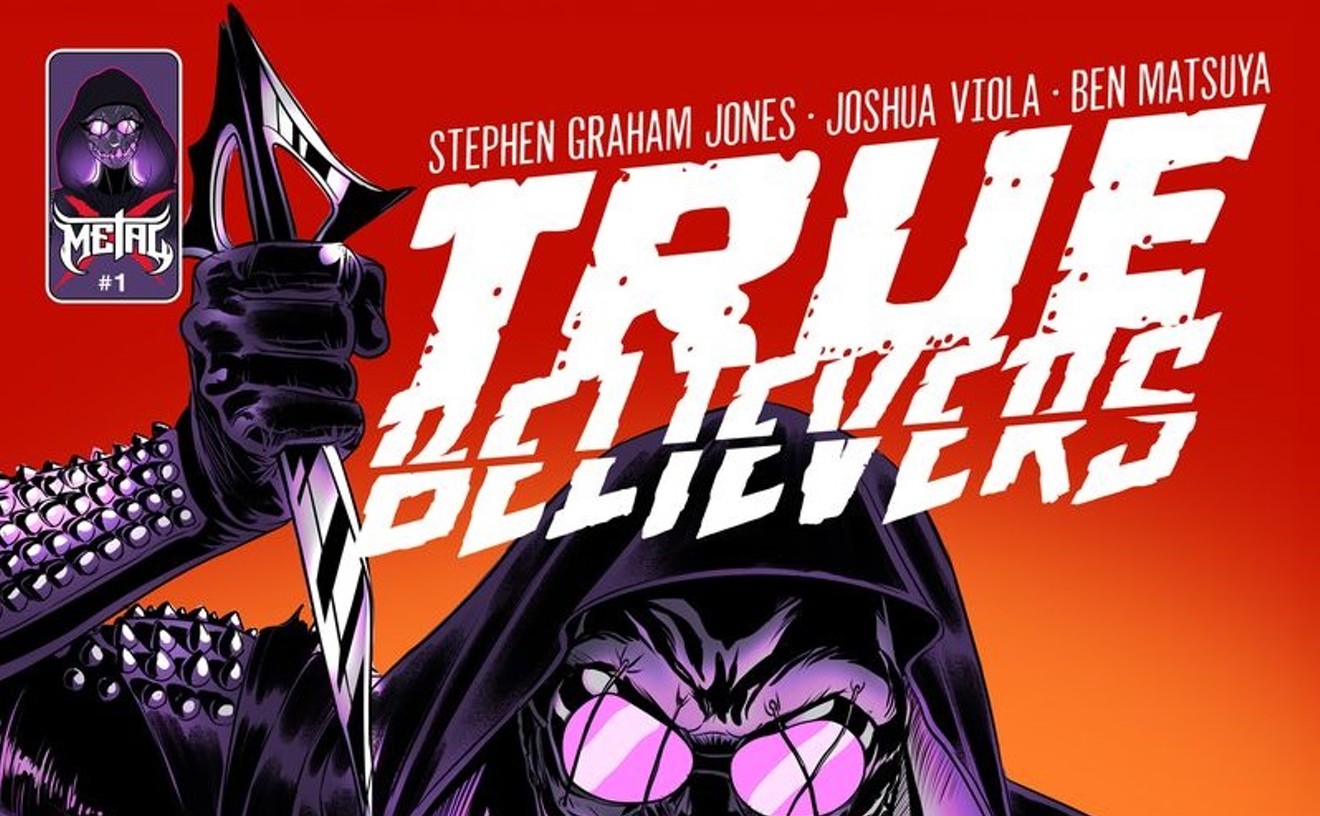For starters, Esser's the public art administrator for the Mayor's Office of Art, Culture and Film. He's the vice president of the increasingly revitalized Pirate co-op gallery. He's a contemporary artist who frequently exhibits in a variety of mediums. And--oh, yes--he's a guitarist for the garage (or is that gallery?) band Saw, whose performance at the Bug culminated the opening festivities for the latest group show he's organized at Pirate: New Work by Greg Esser, Lorre Hoffman, Jill Hadley Hooper.
Even within his art, Esser is all over the place. The appealing pieces he has included fall into three bodies of work so disparate that they could have been created by three different artists.
First there are the sculptures of buildings, a subject taken up before by co-exhibitor Hoffman. (Some viewers also may note the affinity of Esser's buildings to those done by Martha Daniels.) One wall-mounted piece, "Shelter," demonstrates Esser's gift for utilizing various materials to convey different visual effects. The artist lines up six little skyscrapers and tops them off with a gable roof: One of the small buildings is made up of a frame of thin metal rods that has been covered with a sheet of translucent yellow rice paper; another creates the opposite effect with opaque, dark-purple rice paper; a third uses found wood and rusted metal. And so on through the six.
Esser also displays two varieties of shadow boxes: lighted ones, which are substantially black, and unlighted ones, which are mostly white. And they're polar opposites in more ways. In the black boxes, Esser has taken transparencies, sometimes stacked one behind another, to create an effect not unlike a hologram. He then has back-lighted them and masked off the borders with black mat-board. In the wonderful white pieces, images of simple life forms have been silk-screened onto the boxes' glass faces; a white paper board at the back of the box catches the shadows that are created outside the piece by the gallery's lighting.
The work by Hoffman, a non-Pirate making a rare appearance at the gallery, is more clearly of a single piece. This widely admired sculptor--who teaches at the University of Colorado at Denver and has been instrumental in the good works done by the Save Outdoor Sculpture organization--has in the past looked to mundane objects like houses and furniture for her inspiration. For this show she uses boats, life jackets and a fire-damaged oar as symbol-laden elements in her sculptures.
Three small rowboat sculptures are particularly nice. In "Fork in the River," a twig (an element Hoffman has often used in her sculptures) wraps around a carved basswood boat shape that has been painted a gray-putty green. On the sides of the boat is essentially illegible cursive text in pencil. The closely related "Boat" is fashioned of bronze, then made ship-shape with an exquisite verdigris patina. Across the top Hoffman has added to the visual interest by adorning the piece with interlocking swirls in low relief. The third of the diminutive boat sculptures, "Rubber Boat," consists of sheets of rubber cut to shape and then laminated.
Another Hoffman sculpture, "Women and Children First," is a pile of realistic-looking handmade life jackets constructed of a synthetic fabric in a garish Day-Glo orange. The rub to the piece is that Hoffman has filled the life jackets with heavy sand instead of a buoyant material. It's the same sense of futility she conveys in "Catharsis," which pairs a river rock with a charred--and therefore useless--oar. (Oars are showing up so frequently in conceptual sculpture and installations that it's only a matter of time before art-supply stores begin to stock them.)
It's been a while since Hadley Hooper has presented new work, so her lively mixed-media-on-paper pieces are very welcome. These large figural works are an outgrowth of the even larger tar-paper paintings Hadley Hooper, a Westword contributor, showed at Pirate in 1993. Like those, these new works have an enigmatic, dreamlike quality--flames, clouds, animals and buildings are again her subjects.
Hadley Hooper embraces a subtle palette and a smudgy approach to detail that makes her paintings seem as though they are obscured by mist or fog. In "Building," a glowing orange structure is engulfed in black-and-white swirls and smears of oil paint. A heavy dark area at the bottom clearly expresses the horizon. In "Above and Below," which incorporates collaged elements and oil paint, a black-and-white dog is surmounted by orange flames.
All of Hadley Hooper's paintings are beautifully composed and expertly done, so it's hard to choose a standout. But "Fountain," which depicts a dog wearing a collar of arrows, is a strong candidate for the honor.
The ensemble show Esser put together isn't the only thing happening at Pirate.Filling the back gallery is Emily Ripley: New Paintings on Paper. Ripley, riding high after having been selected recently for a prestigious Co-Visions Award from the Colorado Council on the Arts, displays some very weird--though often courageous--offerings.
These pieces are highly experimental; most are executed on odd-shaped pieces of paper rather than rectangular sheets. And instead of being framed, the watercolors have been loosely attached to the walls with pins. This informal approach to presentation effectively links these watercolors to sculpture, since the pieces undulate and won't lie flat. But there is a shortcoming: The fragile materials will not age well. Count on these pieces to disintegrate eventually through accidental tearing.
In a written statement, Ripley claims to have been inspired by advertising images aimed at women. And though it does seem that these abstracts spring from photographic images of some kind, any specific content--feminist or otherwise--is impossible to see. Instead the watercolors look entirely abstract, with the titles, the colors and the shapes vaguely suggesting biological topics. "Jellyfish Blood and Bone Dome," painted on four separate sheets of joined paper, looks like a medical illustration. So does "Azure, Erect," a piece that may--or may not--feature the adult subject matter implied by its title.
The back gallery where Ripley's show takes place, formally known as the Associates Space, is actually the home of a co-op within a co-op. The associate members have fewer obligations than the full-fledged Pirates--they don't have to babysit the gallery on weekends, for example. But the short end of the stick for them is the odd space dedicated to showcasing their work: two stories tall on one side and half a story on the other. It also jogs around quite a bit, forming a rabbit warren of rooms. Nonetheless, in the year since it opened, it's become one of the most exciting places on the local scene.
And the associates aren't the only separate co-op to have their own gallery within Pirate. In the late 1980s, a group of radical photographers including Wes Kennedy, Eric Havelock-Bailey and Shaun Gothwaite came together to form the 2/C group, a co-operative of like-minded types then on the cutting edge of Colorado photography. That group withered away long before it was evicted from Pirate's small side gallery this past winter--in fact, its decline was so apparent that for a year its Pirate home had been known as the space formerly occupied by 2/C, much like the rock star formerly known as Prince.
But a new co-op has taken 2/C's place in the side gallery. The ILK co-op describes itself as a "group of young, fresh faces" who make the distinction that they are not "a space looking for people to fill it" but rather a "community" in need of a space. The inaugural show doesn't bear this out, and there seems to be little that connects one artist to another in ILK. To be honest, this show is as inauspicious as was 2/C's slow decline. But there's always next time.
New Work by Greg Esser, Lorre Hoffman, Jill Hadley Hooper and Emily Ripley: New Paintings on Paper, both through March 10 at Pirate: A Contemporary Art Oasis, 3659 Navajo Street, 458-6058.










